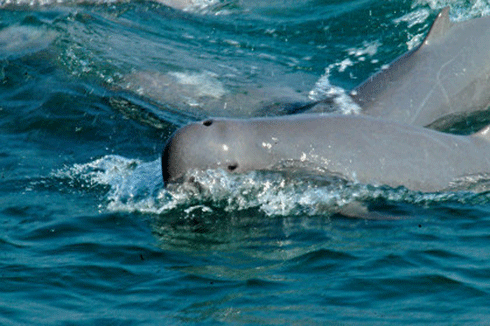
|
Published: 23 April 2014
Better turbine design makes dams more fish friendly
Think of the pressure change you feel when an elevator zips you up multiple floors in a tall building. Imagine how you'd feel if that elevator carried you all the way up to the top of Mt Everest – in the blink of an eye.

|
|
Irrawaddy dolphins in the Mekong are among the river species that will benefit from more ‘fish friendly’ dam design. Credit:
Somchai Mananunsap
|
That's similar to what many fish experience when they travel through the turbulent waters near a dam. For some, the change in pressure is simply too big, too fast, and they die or are seriously injured.
In an
They found that modifying turbines to minimise dramatic shifts in pressure offers an important way to keep fish safe when passing through dams.
PNNL researchers are working with officials and scientists from Laos, Brazil, and Australia to apply lessons learned from experience in the Pacific Northwest, where salmon is king and water provides about two-thirds of the region's power. There, billions of dollars have been spent since 1950 to save salmon endangered largely by the environmental impact of hydropower.
‘Hydropower is a tremendous resource, often available in areas far from other sources of power, and critical to the future of many people around the globe,’ said Richard Brown, a senior research scientist at PNNL and the lead author of the Fisheries paper.
In Brazil, several dozen dams are planned along the Amazon, Madeira and Xingu rivers – an area that teems with more than 5000 species of fish, and where some of the largest hydropower projects in the world are being built.
In south-east Australia, hydropower devices are planned in the area drained by the Murray-Darling river system. And in Southeast Asia, hundreds of dams and smaller hydro structures are planned in the Lower Mekong River Basin.
Dams vary considerably in the challenges they pose to migrating fish, and the challenges are magnified when a fish must pass through more than one dam or hydro structure.
At some, mortality is quite high, while at others, most fish are able to pass over or through a single dam safely, thanks to extensive measures to keep fish safe. Some fish spill harmlessly over the top, while others pass through pipes or other structures designed to route fish around the dam or steer them clear of the energy-producing turbines.
At most dams, the tremendous turbulence of the water can hurt or disorient fish, and the blades of a turbine can strike them. The new study focuses on a third problem, barotrauma – damage that happens at some dams when a fish experiences a large change in pressure.
Depending on its specific path, a fish travelling through a dam can experience an enormous drop in pressure, similar to the change from sea level to the top of Mt. Everest, in an instant. Just as fast, as the waters swirl, the fish suddenly finds itself back at its normal pressure.
Those sudden changes can have a catastrophic effect on fish, most of which are equipped with an organ known as a swim bladder – like a balloon – to maintain buoyancy at a desired depth. When the fish goes deeper and pressures are greater, the swim bladder shrinks; when the fish rises and pressure is reduced, the organ increases in size.
For some fish, the pressure shift means the swim bladder instantly expands four-fold or eight-fold, like an air bag that inflates suddenly. This rapid expansion can result in internal injuries or even death.
Factors at play include the specific path of a fish, the amount of water going through a turbine, the design of the turbine, the depth of water where the fish usually lives, and the physiology of the fish itself.
‘To customise a power plant that is the safest for the fish, you must understand the species of fish in that particular river, their physiology, and the depth at which they normally reside, as well as the tremendous forces that the fish can be subjected to,’ said Brown.
The research shows that keeping minimum pressures higher near the turbine is the key to preventing barotrauma. This reduces the amount of pressure change a fish is exposed to and is a crucial component for any turbine that is truly ‘fish friendly’. Preventing those extremely low pressures also protects a turbine from damage, reducing shutdowns and costly repairs.
Source: PNNL/EurekAlert!



